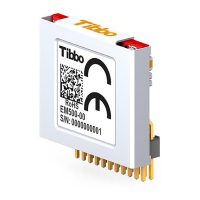274Tibbo Project System (TPS)
© Tibbo Technology Inc.
7.2.5.5
[AUD] Tibbits That Require Audio Functionality
Tibbits that require AUDIO functionality can only work in "AUDIO" sockets. At the
moment, only our Linux TPP boards support AUDIO Tibbits.
7.2.5.6
[MMC] Tibbits That Require MMC (SD) Functionality
Tibbits that require MMC functionality can only work in "MMC" sockets. At the
moment, only our Linux TPP boards support MMC Tibbits.
7.2.5.7
[USB] Tibbits That Require USB Functionality
Tibbits that require USB functionality can only work in "USB" sockets. At the
moment, only our Linux TPP boards support USB Tibbits.
Combining "C" and "M" Tibbits
"M" and "C" Tibbits were designed to work together and complement each other. A
single tile can accommodate Tibbits of all possible form factors.
Narrow "M" Tibbits can be mixed with wide "C" devices and vice versa, but there are
rules for this. All such combinations can only take place within the space of a single
tile. Under no circumstances should Tibbits be arranged in ways that share them
between tiles. In other words, Tibbits can't cross tile borders.
The four possible combinations are:
C1 + M1
C2 + M2
C2 + Two M1s
Two C1s + M2
There is also a generous degree of interchangeability. For example, Tibbit #02
(universal RS232/422/485 port) can be wired to Tibbit #19 (DB9 connector). The
#02 can also be used with #20 ("nine terminal blocks" device). Who knows -- maybe
this, and not the DB9, is what's need in your project! This is the main reason why
Tibbits were split into "modules" and "connectors".

